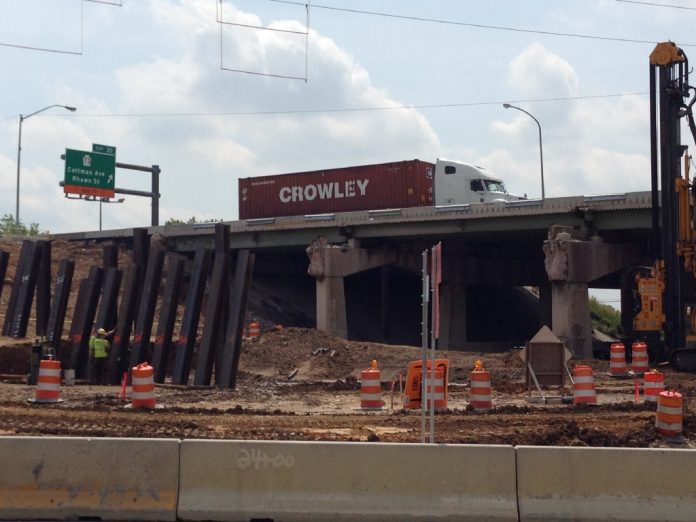Get used to it: The $212.3 million project is in Stage Three of a six-stage process. WILLIAM KENNY / TIMES PHOTO
Officials from the Pennsylvania Department of Transportation have two messages for motorists who are getting tired of dealing with the ongoing construction at Interstate 95’s Cottman Avenue interchange.
It’s not that bad, and you might as well get used to it.
The $212.3 million project — which is the largest single construction contract in PennDOT’s history — is in Stage Three of a six-stage process. Work is expected to continue for at least three more years with a projected completion date in mid-2016.
“I’ve driven through the [traffic] pattern. It doesn’t take you that long to get through it,” said Harold Windisch, the senior assistant construction engineer for PennDOT’s District 6–0, which covers the five-county Philadelphia region. “But the lanes are narrower and the speed limit is slower.”
“People have to be patient going through the work zone,” added Manny Anastasiadis, an assistant traffic engineer for the district.
The work zone spans about 1.4 miles of the highway from just south of the Academy Road interchange to about 1,000 feet south of Levick Street. Walsh Construction of Canonsburg is the general contractor. Work crews will repave the highway and rebuild seven “mainline” bridges, as well as a southbound on-ramp from Cottman Avenue.
Work will also include the installation of retaining walls along the highway and new water and sewer mains along Wissinoming Street. New State road will be repaved and Princeton Avenue extended eastward toward the Delaware River. Improvements will be made to the southbound on-ramp at Bleigh Avenue and to the “intelligent transportation system” (ITS) in the area, which features cameras and digital signs.
To keep traffic moving, crews have been working on one-third of the eight-lane highway at a time, with the other two-thirds open to traffic. At the moment, crews are working on the southbound side of the highway, with southbound motorists routed through the median.
Using this method, PennDOT plans to keep three lanes open in each direction at all times during the daytime and early evening hours, notwithstanding emergencies. The highway typically handles 118,000 vehicles per day, with traffic heavier on weekdays. Traffic is typically lighter in the summer because schools are out of session and many motorists leave town on vacation.
The project has impacted and will continue to impact city streets in the area of the construction zone. Routes that have been closed partially or fully include Milnor Street, State Road and New State Road.
Also, the southbound I-95 exit ramp at Bleigh Avenue is closed. The official detour calls for motorists to exit at Academy Road and take Torresdale Avenue south to Cottman Avenue. However, many motorists have found different routes. Some are taking State Road from Bucks County southbound through the work area. Neighbors in East Torresdale have complained to the Philadelphia Department of Streets.
“It wasn’t part of the original [traffic] study. [But] we’re aware of it. The city has reached out to us,” Windisch said.
PennDOT hopes to formulate a plan to mitigate the State Road traffic before the end of the summer.
Businesses that operate throughout the area are also very concerned about highway construction progress. On June 26, the Greater Northeast Chamber of Commerce hosted a meeting with PennDOT officials at Franklin Mills.
Chamber members “wanted to know what the length of time would be” for the work, said Al Taubenberger, the Chamber president. “It’s going to be long-term, but people are willing to sacrifice that for permanent improvements.
According to Windisch, PennDOT constantly monitors traffic flow on the highway through a system of cameras. The public can access live video from the cameras, too, via the 511PA.com Web site. Construction information is available at 95revive.com. Motorists may use the latter site to sign up for e-mail and text message alerts about traffic-related issues. ••





